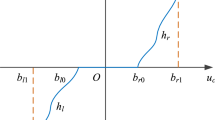Abstract
Chaotic neural networks are versatile systems that attract the attention of researchers while the control of their output is a challenging problem. The objective of this paper is to control chaotic neural networks by a novel combinatorial method adopted from two controlling strategies: the threshold and the damping mechanisms. In one sense, the threshold mechanism restricts the refractoriness internal states with a time varying threshold. The limiting threshold depends on a control signal which is a control signal provided by an inner loop as a function of the network internal state. In another sense, the damping mechanism modifies the network’s dynamics to stabilize the chaotic behaviour basically when the threshold mechanism fails. This mechanism is an outer feedback control loop evaluated when the model is chaotic and exponentially stabilizes it. Two simulation examples are considered in this paper which checks the performance of the proposed method compare to the results of the conventional methods. Comparative results imply the superiority of the proposed controlling method compare to the counterparts on both benchmarks.





















Similar content being viewed by others
References
Adachi M, Aihara K (1997) Associative dynamics in a chaotic neural network. Neural Netw 10:83–98
Aihara K, Takabe T, Toyoda M (1990) Chaotic neural networks. Phys Lett A 144:333–340
Boostani R, Moradi MH (2004) A new approach in the BCI research based on fractal dimension as feature and Adaboost as classifier. J Neural Eng 1:212–219
He Y, Wang L (2000) Chaotic neural networks and their applications In: IEEE Proceedings of the 3rd world congress on intelligent control and automation. https://doi.org/10.1109/WCICA.2000.863345
He G, Cao Z, Chen H, Zhu P (2003) Controlling chaos in a neural network based on the phase space constraint. Int J Mod Phys B 17:4209–4214
He G, Kuroiwa J, Ogura H, Zhu P, Cao Z, Chen P (2004) A type of delay feedback control of chaotic dynamics in a chaotic neural network. IEICE Trans Fundam 87:1765–1771
He G, Shrimali MD, Aihara K (2007) Partial state feedback control of chaotic neural network and its application. Phys Lett A 371:228–233
He G, Chen L, Aihara K (2008a) Associative memory with a controlled chaotic neural network. Neurocomputing 71:2794–2805
He G, Shrimali MD, Aihara K (2008b) Threshold control of chaotic neural network. Neural Netw 21:114–121
Kafraj MS, Parastesh F, Jafari S (2020) Firing patterns of an improved Izhikevich neuron model under the effect of electromagnetic induction and noise. Chaos Solitons Fractals 137:109782
Karimzadeh F, Seraj E, Boostani R, Torabi-Nami M (2015) Presenting efficient features for automatic CAP detection in sleep EEG signals, IEEE 38th international conference on telecommunications and signal processing (TSP), pp 448–452
Kushibe M, Liu Y, Ohtsubo J (1996) Associative memory with spatiotemporal chaos control. Phys Rev E 53:4502–4508
Li Y, Zhu P, Xie X, Chen H, Aihara K, He G (2013) Controlling a chaotic neural network for information processing. Neurocomputing 110:111–120
Medvedeva TM, Lüttjohann A, Van Luijtelaar G and Sysoev IV (2016) Evaluation of nonlinear properties of epileptic activity using largest Lyapunov exponent. In: Third international symposium on optics and biophotonics, vol 9917, p 991724
Mizutani S, Sano T, Uchiyama T, Sonehara N (1998) Controlling chaos in chaotic neural networks. Electron Commun Jpn Part III Fundam Electron Sci 81:73–82
Moghadam NN, Nazarimehr F, Jafari S, Sprott JC (2020) Studying the performance of critical slowing down indicators in a biological system with a period-doubling route to chaos. Phys A Stat Mech Appl 544:123396
Nakamura K, Nakagawa M (1993) On the associative model with parameter controlled chaos neurons. J Phys Soc Jpn 62:942–2955
Noruzi M, Sabeti M, Boostani R (2017) A comprehensive approach towards classification and prediction of ventricular tachycardia and ventricular fibrillation. Biomed Eng Appl Basis Commun 29:1750039
Panahi S, Rostami Z, Rajagopal K, Namazi H, Jafari S (2020) Complete dynamical analysis of myocardial cell exposed to magnetic flux. Chin J Phys 64:363–373
Parlitz U (2016) Estimating Lyapunov exponents from time series. Chaos detection and predictability. Springer, Berlin, pp 1–34
Pyragas K (1992) Continuous control of chaos by self-controlling feedback. Phys Lett A 170:421–428
Roopaei M, Boostani R, Sarvestani RR, Taghavi MA, Azimifar Z (2010) Chaotic based reconstructed phase space features for detecting ventricular fibrillation. Biomed Signal Proc Control 5:318–327
Sabeti M, Katebi S, Boostani R (2009) Entropy and complexity measures for EEG signal classification of schizophrenic and control participants. Artif Intell Med 47:263–274
Sarvestani RR, Boostani R, Roopaei M (2009) VT and VF classification using trajectory analysis. Nonlinear Anal Theory Methods Appl 71:55–61
Shafiei M, Jafari S, Parastesh F, Ozer M, Kapitaniak T, Perc M (2020) Time delayed chemical synapses and synchronization in multilayer neuronal networks with ephaptic inter-layer coupling. Commun Nonlinear Sci Numer Simul 84:105175
Tourani S, Rahmani Z, Rezaei B (2016) Adaptive observer-based projective synchronization for the chaotic neural networks with mixed tike delays. Chin J Phys 54:285–297
Author information
Authors and Affiliations
Corresponding author
Rights and permissions
About this article
Cite this article
Abolpour, N., Boostani, R. & Masnadi-Shirazi, M.A. State Feedback Method to Control Chaotic Neural Network Based on the Dynamic Phase-Space Constraint. Iran J Sci Technol Trans Electr Eng 45, 721–731 (2021). https://doi.org/10.1007/s40998-021-00407-y
Received:
Accepted:
Published:
Issue Date:
DOI: https://doi.org/10.1007/s40998-021-00407-y




